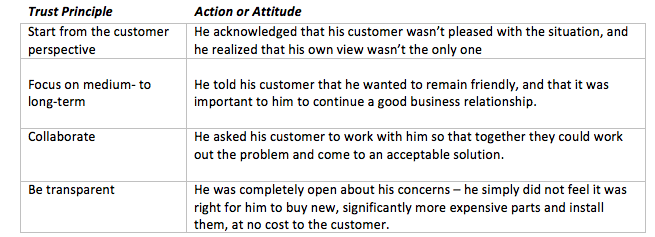When to Offer a Lower Price
Few decisions in business have such dramatic effects on customer perception as how you handle your pricing – in particular, when and how you offer discounts.
People may evaluate your products, or your service offerings, by averaging out multiple experiences. But drop your price just once, and see how hard it is to recover. For a large-scale example, recall Bill Ackman’s painful failure to revamp the image of JC Penney—away from frequent discounts to everyday low prices as a strategy. For a more personal example, just ask yourself – how often are you able to recover your normal pricing rates after having given an initial discount?
Yet in professional services and complex businesses, we play with offering discounts all the time. We tell ourselves, ‘The client wants it.’ ‘We might lose without it.’ ‘The competitor is cutting rates.’ ‘We can’t look inflexible.’ ‘What’s the big deal, how often do we get full rate anyway?’
Yet you’re right to be suspicious about the effectiveness of random hip-shooting when it comes to offering a lower price. Shouldn’t we have some kind of strategy?
Don’t Just Stand There: Stand for Something
There is no one “right” approach to offering discounts. Your approach will vary with your business, your objectives, and your markets. But there are some things every approach should do:
- You should have a rule for when to discount
- That rule should be easily explainable to clients
- You should be willing to live by the rule.
That may sound obvious. But how often have you heard things like, “Don’t tell Bill that we gave XYZ got that price; it’ll only encourage him to want it,” or “Those guys’ll do anything to get the business.” Those statements indicate a lack of policy – which is death on your reputation.
What to Stand For
Again, your business will vary. Here’s what I decided for mine. I run a high-end professional services business, offering speaking, training, coaching, and related services. I want to be known for solid relationships, high quality, professionalism, and subject matter expertise. And in my case, because the subject matter is trust, I also need to be seen as completely above suspicion.
It’s clear, then, that I need to articulate and live by some rules about when to discount. Here’s what I came up with over the years.
1. Frequency. I want to be at the opposite end of the spectrum from a JC Penney strategy of frequent discounting. I don’t want clients looking for bargains. If they’re looking to price shop, I want to send a not-so-subtle message that they’re in the wrong place.
2. Exceptions. To help that message, I need to be very clear about when and where discounts are appropriate. In my business, I can clearly state three such situations:
Volume. In my business, perhaps the biggest cost is cost of sales (the time, expense, and investment it takes to generate professional fees). It stands to reason that if someone can reduce my cost of sales, I have room to pass some of those savings along in lower prices.
The biggest example of that is simply a volume discount. The economics of selling one training session to 10 clients vs. selling 10 training sessions to one client are pretty clear. I am happy to receive multiple orders, and I’m happy to offer volume discounts to reflect it.
For me, volume discounts are easy to explain and easy to justify.
Special Situations—For Me. Sometimes I want to work in a new industry or with a novel offering.
Those situations are as important for me as they are for the client. In those cases, I will offer a significant discount. I don’t want to shave nickels; I want to send a message about what is important and what isn’t. And in those cases, it’s about the learning. Those kinds of discounts rarely happen.
Special Situations—For the Client. Non-profits never have the kind of money that corporations do; most associations are limited as well. I don’t say yes to all those requests, but when I do, it’s only reasonable to price “off-label.” (Government is a special case, and one I won’t go into here.) And yes, there are a few ‘friends’ discounts from time to time.
3. Non-Exceptions. That’s about it. That leaves a lot of other situations where I choose not to discount. It’s worth pointing them out:
Pleas for budget. Sorry, I have a list of charities I contribute to: corporations with a squeezed budget are not on the list. Make that ‘never on the list’ if you’re in the pharmaceutical or financial services industries, or if you have office space in midtown Manhattan.
Bargaining. I have a simple way of declaring that this is not a bazaar: transparency. I explain my business model, explain when and how I give discounts, and – that’s it. I recall one client who, after our initial phone call, said, “I assume that if we go ahead, you’ll grant us our customary 20% discount.” He assumed wrongly.
The Positive Alternative. “Just say no” may (or may not) be a good strategy for drug usage, but it’s not a satisfactory answer to a client on the receiving end. None of us like to be told no, even with a great explanation.
Over the years, I developed another business practice that turns out to have a great side benefit: making people appreciate my saying “no” to discount requests. That practice is to simply take a few minutes extra to talk with them about their situation and refer them to someone else who can help them.
I am a very small player in all the markets I play in. I am far from the only one providing great service. If someone doesn’t happen to fit my business model, they may be caviar and champagne for someone else’s model.
It costs nothing to spend a little time thinking about alternatives for clients who don’t quite fit with my needs, and it generates huge amounts of goodwill. It’s a small investment with a big marketing return: they may come back when they have a need that is a fit with me, and they may speak well of me to others. Not to mention, they’re no longer complaining about how I don’t discount.
Again, my model is not the only one. You have to decide what’s right for you. But whatever it is, it should be clear, it has to be explainable, and you should be willing to live by it.

 Let’s get tactical.
Let’s get tactical. There are many ways to think about sales and selling. You can focus on value propositions, sales processes, sales management, motivation, techniques, and models. In this blogpost series, I focus on something else that’s common in sales – fear.
There are many ways to think about sales and selling. You can focus on value propositions, sales processes, sales management, motivation, techniques, and models. In this blogpost series, I focus on something else that’s common in sales – fear.